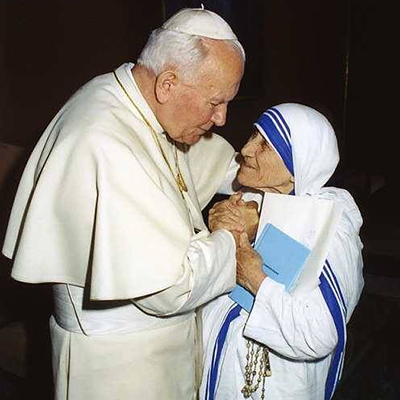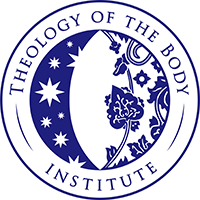

Holy Friendship in a Hypersexualized World
Holy Friendship in a Hypersexualized World

A wonderful article appeared in The Federalist a few years back by D.C. McAllister titled “How To Stop Sexualizing Everything.” It tapped into the schizophrenic character of our modern age, particularly in American culture, that surrounds our expressions of intimacy. Essentially, she posited, we either fearfully avoid touch and intimacy as it might be misread as a sin or a sexual advance, or we completely give in, and all that we touch is tinged with sexual undertones and innuendos. McAllister notes “The effect of these two warring attitudes – Puritanism and sexualization – has had a distorting effect on friendship. On the one hand, people don’t feel free to show emotions. On the other, when they do, those feelings are sexualized.”
A 2016 BBC documentary called “The Secret Letters of Pope John Paul II” perfectly illustrates this distorted dichotomy. For decades, St. John Paul II held a well-known relationship with Dr. Anna-Teresa Tymieniecka, a Polish philosopher who was an expert in the work of German philosopher Edmund Husserl. The pope’s shared interest in Husserl’s phenomenology allowed the two to form a friendship over the years (albeit, not without its difficult moments – see George Weigel’s excellent article on that backstory here). She was a married woman with three children, living in America. He, at the time they met, was a cardinal in the Church. Their correspondence lasted well into old age.
Journalist Ed Stourton, who crafted the documentary, proposes that the decades-long relationship was somehow, for at least one of the parties involved, romantic. His claims are “substantiated” by Emeritus Professor Eamon Duffy of the University of Cambridge, who states in the interview, “Clearly there’s an element of playing with fire when you’ve got a strongly heterosexual man and an attractive woman in a very intense relationship that is cultivated and which engages mind at a high level of intensity. There’s danger everywhere.”
This thought that a male and female friendship simply by its very nature is “dangerous” is given further credence in the remarks of someone Stourton refers to as a “trainee priest” (my research revealed that a “trainee priest” is also known as a seminarian). John Cornwell apparently attended seminary from 1953 to 1958. He states that back then “The perception was that even if you had a close association of friendship with the woman, this could be what was known as an occasion of sin and an occasion of sin was as bad as if you’d actually done it.” This sad (and completely incorrect) articulation of what sin consists of is followed by another interviewee who states that their “training meant most priests would have been wary of such a close relationship. The most natural reaction would have been for him to terminate contact.”
Ironically, the language in this interview reveals to viewers and readers of this breaking story the deepest scandal of all, which has nothing to do with St. John Paul II. It is the scandal that all too many men and women today are incapable of imagining an intimate relationship that does not somehow involve some sort of sexually romantic overtone.
In truth, the Church has a long history of examples of men and women who have formed intimate and affectionate relationships that did not involve sexual relations. They were known as friendships (this is a wonderful word we should restore to the modern lexicon). In fact, St. John Paul II had numerous friendships with women that lasted decades and included letters, phone calls, shared meals, and walks together. The BBC footage seems to imply that this particular relationship with Dr. Tymieniecka was isolated and the meetings exclusive. But the fact is, they were not. St. John Paul II was a magnanimous figure who loved people deeply, and was rather transparent about his friendships. He was also prudent, meeting men and women together for those private meals and taking vacations with friends or families together. In the image of St. John Paul II and Dr. Tymieniecka standing beside a car, one should realize a third person took the photo. I imagine it was her husband.
Now regarding the correspondence, here is an excerpt from a letter:
“I know you have complete confidence in my affection; I have no doubt about this and delight in the thought. I want you to know and to believe that I have an intense and very special desire to serve you with all of my strength. It would be impossible for me to explain either the quality or the greatness of this desire that I have to be at your service, but I can tell you that I believe it is from God, and for that reason, I cherish it and every day see it growing and increasing remarkably… God has given me to you; so consider me as yours in Him, call me whenever you like…”
I’m sorry, I tricked you just there. This was actually an exchange between St. Francis de Sales to St. Jane de Chantal, dated June 24, 1604. After the death of her husband, St. Francis served as her spiritual director for years, giving her counsel in forming a new religious community. (I don’t have access to an extended quote from St. John Paul II’s letters to Dr. Tymieniecka, and would prefer not to cherry pick one out at this point as the BBC interview did.)
Regardless, here is an intimate note, man to woman, celibate man to widowed mother. How did you feel in reading that exchange? Did it make you uncomfortable? Were you shocked? Did you feel it was inappropriate? I know it really struck me personally when I first read it. I found it to be astoundingly beautiful, and I felt duped and double-crossed by this hyper-sexualized culture we live in because I too felt a little manipulated as it were to see romance when I read those words holding such fervent love. But who has the larger issue here? Who needs a little restoration of that original vision we’ve been called to?
The examples of chaste and simultaneously fervent love go on, nonetheless, and in each we are challenged to see others first as “occasions of grace” rather than “occasions of sin.” By this grace, in the words of St. John Paul II, “we come to an ever greater awareness of the gratuitous beauty of the human body, of masculinity and femininity. This gratuitous beauty becomes a light for our actions….”
Over a two-year period that led up to her own early death, Saint Thérèse of Lisieux and a seminarian named Maurice would exchange 21 letters in total. He wrote 11 and the Little Flower wrote 10. For both of these holy souls, the letters reveal a love that was fully human and completely chaste. St. Thérèse wrote in one note: “In your letter of the 14th you made my heart tremble with joy. I understand better than ever how much your soul is the sister of my own, since it is called to lift itself up to God by the ELEVATOR of love and not to climb the hard stairway of fear….” Later, as he was about to be sent on mission, she wrote “When my dear little brother leaves for Africa, I shall follow him not only in thought and in prayer; my soul will be with him forever. …”
Let’s look at another intimate exchange, now between men, from over 1,600 years ago: “…To talk and jest together, to do kind offices by turns; to read together honied books; to play the fool or be earnest together… (to) long for the absent with impatience; and welcome the coming with joy. These and the like expressions, proceeding out of the hearts of those that loved and were loved again, by the countenance, the tongue, the eyes, and a thousand pleasing gestures, were so much fuel to melt our souls together, and out of many make but one. This is it that is loved in friends…”
That was St. Augustine, taken from his own intimate and perennially modern autobiography Confessions (Chapter 8, section 13), written between 397 and 400 AD. For modern ears, this level of intimacy between men can only be seen as some kind of closet homosexuality. The same minds, tinged again by a culture inundated by sexual allusion and innuendo in all things, even place a gay frame around the relationship between David and Jonathan in 1 Samuel 18:1,3: “As soon as he had finished speaking to Saul, the soul of Jonathan was knit to the soul of David, and Jonathan loved him as his own soul.”
We have become, in the words of St. John Paul II himself, “masters of suspicion,” incapable of seeing how human interactions could ever rise above mere sexual gratification and appropriation.
This is nothing new. During the beatification process for Padre Pio, in 1990, the case was blocked after a stash of letters were revealed that the holy Franciscan had written to his spiritual daughter, as he called her, Cleonice Morcaldi. He had met her around 1930 when she was a child, orphaned from both parents. St. Padre Pio had promised her dying mother he would take care of her like a daughter. Some investigators however felt the letters to be too affectionate.
Man and woman. This is holy ground. This is sacred ground, and in this place we are called to a deep self-mastery, and a healthy recognition of our own hearts and where we stand in the ability to truly see one another. I have placed several links to resources below and encourage readers to go further, to pray more deeply about this lost art of friendship, of holy friendship. It must be rekindled. It will take work and prayer and much patience, especially in this present darkness. But with grace we can reclaim a beautiful gift, and our vision of one another can indeed be restored. It is a hope within reach. It is our inheritance and a promise too. “Jesus came to restore creation to the purity of its origins” (Catechism, 2336). I’ll close with a wonderful and deeply personal word from St. John Paul II, originally signed on Feb. 8, 1994 but was not printed until 2006:
“God has given me many people, both young and old, boys and girls, fathers and mothers, widows, the healthy and the sick. Always, when he gave them to me, he also tasked me with them, and now I see that I could easily write a separate book about each of them—and each biography would ultimately be on the disinterested gift man always is for the other. Among them were the uneducated, for instance factory workers; there were also students, university professors, doctors and lawyers, and finally priests and the consecrated religious. Of course, they included both men and women. A long road led me to discover the genius of woman, and Providence itself saw to it that the time eventually came when I really recognized it and was even, as it were, dazzled by it.”
Saint John Paul the Great, Poet of the Divine Mysteries and Apostle of the Beauty of the Human Person, pray for us!
Share your thoughts on this reflection’s Facebook post here.
_____
Resources:
A Meditation on Givenness by St. John Paul II
http://www.communio-icr.com/articles/view/a-meditation-on-givenness
But I Have Called You Friends; Reflections on the Art of Christian Friendship by Mother Mary Francis
Love and Responsibility by Karol Wojtyla
“How to Stop Sexualizing Everything” by D.C. McAllister
http://thefederalist.com/2015/12/28/how-to-stop-sexualizing-everything/
Bill Donaghy is senior lecturer for TOB Institute. Having worked in mission, evangelization, and education since the early 1990s, Bill joined the faculty of the TOB Institute in 2010 and became a full-time member of the team as content specialist in 2013. With a background in visual arts, philosophy, and systematic theology, he has given talks and retreats to bishops, priests, deacons, religious, and the lay faithful throughout the country and internationally. Bill is the co-author with Chris Stefanick of the popular program RISE: 30 Day Challenge for Men and is a proud husband and father of four.



